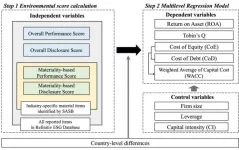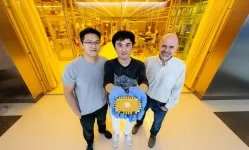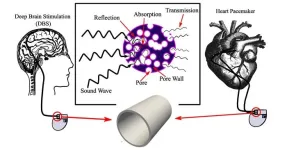(Press-News.org) Siddarth Kara’s bestseller, “Cobalt Red: How the Blood of Congo Powers Our Lives,” focuses on problems surrounding the sourcing of cobalt, a critical component of lithium-ion batteries that power many technologies central to modern life, from mobile phones and pacemakers to electric vehicles.
“Perhaps many of us have read how lithium-ion batteries are vital for energy storage technologies,” says Eric Schelter, the Hirschmann-Makineni Professor of Chemistry at the University of Pennsylvania. “But how material that make up such batteries are sourced can be concerning and problematic, both ethically and environmentally.”
Schelter says that cobalt mining in the Democratic Republic of Congo, which supplies about 70% of the world’s cobalt, raises concerns due to environmental degradation and unsafe working conditions, and that large-scale mining disrupts ecosystems, can contaminate water supplies, leaving lasting environmental damage. In addition, he notes that a looming cobalt shortage threatens to strain global supply chains as demand for battery technologies continues to grow.
To that end, an area of research his lab has been focusing on is the separation of battery-critical metals like nickel and cobalt. In a new paper, published in the journal Chem, Schelter’s team and collaborators at Northwestern University presented an “easier, more sustainable, and cheaper way to separate both from materials that would otherwise be considered waste.”
“Our chemistry is attractive because it’s simple, works well, and efficiently separates nickel and cobalt—one of the more challenging separation problems in the field,” Schelter says. “This approach offers two key benefits: increasing the capacity to produce purified cobalt from mining operations with potentially minimal environmental harm, addressing the harshness of traditional purification chemicals, and creating value for discarded batteries by providing an efficient way to separate nickel and cobalt.”
The right ingredients for selective separation
Typically, the researchers say, cobalt is often produced as a byproduct of nickel mining by way of hydrometallurgical methods such as acid leaching and solvent extraction, which separates cobalt and nickel from ores. It’s an energy-intensive method that generates significant hazardous waste.
The process Schelter and the team developed to circumvent this is based on a chemical-separation technique that leverages the charge density and bonding differences between two molecular complexes: the cobalt (III) hexammine complex and the nickel (II) hexammine complex.
“A lot of separations chemistry is about manifesting differences between the things you want to separate,” Schelter says, “and in this case we found conditions where ammonia, which is relatively simple and inexpensive, binds differently to the nickel and cobalt hexammine complexes.”
By introducing a specific negatively charged molecule, or anion, like carbonate into the system, they created a molecular solid structure that causes the cobalt complex to precipitate out of the solution while leaving the nickel one dissolved. Their work showed that the carbonate anion selectively interacts with the cobalt complex by forming strong “hydrogen bonds” that create a stable precipitate. After precipitation, the cobalt-enriched solid is separated through filtration, washed with ammonia, and dried. The remaining solution contains nickel, which can then be processed separately.
“This process not only achieves high purities for both metals—99.4% for cobalt and more than 99% for nickel—but it also avoids the use of organic solvents and harsh acids commonly used in traditional separation methods,” says first author Boyang (Bobby) Zhang, a graduate student in Penn’s School of Arts & Sciences and a Vagelos Institute for Energy Science and Technology Graduate Fellow. “It’s an inherently simple and scalable approach that offers environmental and economic advantages.”
Techno-economic and life cycle analyses
In evaluating the real-world applicability of their new method, the team, led by Marta Guron, conducted both techno-economic analysis and life-cycle assessment, with the former revealing an estimated production cost of $1.05 per gram of purified cobalt, substantially lower than the $2.73 per gram associated with a reported separations process.
“We focused on minimizing chemical costs while also using readily available reagents, which makes our method potentially competitive with existing technologies,” Schelter says.
The life-cycle analysis found that eliminating volatile organic chemicals and hazardous solvents allows the process to significantly reduce environmental and health risks, which was supported by metrics like Smog Formation Potential and Human Toxicity by Inhalation Potential, where the process scored at least an order of magnitude better than traditional methods.
“This means fewer greenhouse gas emissions and less hazardous waste, which is a seriously big win for both the environment and public health,” says Zhang.
Cleaner path forward
Owing to how the team accomplished their separation, Schelter says, there’s an exciting fundamental science aspect of this work that he thinks they can take in many different directions, even for other metal separation problems.
“Based on the unique set of molecular recognition principles we identified through the course of this work, I think we can extend this work in many different directions,” he says. “We could apply it to other metal separation problems, ultimately driving broader innovation in sustainable chemistry and materials recovery.”
Eric Schelter is the Hirschmann-Makineni Professor of Chemistry in the Department of Chemistry at the School of Arts & Sciences at the University of Pennsylvania.
Boyang (Bobby) Zhang is a Vagelos Institute for Energy Science and Technology Graduate Fellow in the Schelter Group at Penn Arts & Sciences.
Marta Guron is an adjunct lecturer in the Department of Chemistry and project manager in the Office of Environmental and Radiation Safety.
Other authors are Andrew J. Ahn, Michael R. Gau, and Alexander B. Weberg from Penn and Leighton O. Jones and George C. Schatz of Northwestern University.
This research was supported by the Vagelos Institute for Energy Science and Technology at Penn, Vagelos Integrated Program in Energy Research at Penn, National Science Foundation Center (Award CHE-1925708), Center for Advanced Materials for Energy Water Systems of the U.S. Department of Energy (Grant 8J-30009-0007A), and Research Corporation for Science Advancement (Award #CS-SEED-2024-022).
END
A greener, cleaner way to extract cobalt from ‘junk’ materials
Penn researchers led a collaborative effort pioneering safer, more sustainable technique to extract elements critical to battery-powered technologies. Findings pave the way for getting value from materials that would otherwise be considered waste.
2024-12-10
ELSE PRESS RELEASES FROM THIS DATE:
Better environmental performance boosts profits and cuts costs
2024-12-10
Fukuoka, Japan—Sustainable practices in business are more than just an ethical responsibility; they make sound financial sense. Researchers from Kyushu University, in a study published on December 10, 2024, in Corporate Social Responsibility and Environmental Management, reveal that companies with better environmental performance and transparent disclosures can lower costs and boost profits.
Investors are increasingly recognizing companies' contributions toward carbon neutrality, driving the growth of environmental, social, and governance (ESG) investing. To support this trend, the Sustainability Accounting Standards Board (SASB) has provided an industry-specific framework ...
Making self-driving cars safer, less accident prone
2024-12-10
Self-driving cars rely on artificial intelligence to predict where nearby cars will go. But when those predictions don’t match reality, that discrepancy can potentially lead to crashes and less safe roadways.
That’s why a recent study from the University of Georgia developed a new AI model to make self-driving cars safer.
This study introduces an AI model for self-driving cars, designed to predict the movement of nearby traffic and incorporate innovative features for planning safe vehicle movements.
"The planned trajectory of the self-driving car may turn out to collide with the actual trajectory of another vehicle.” —Qianwen Li, College ...
Rethinking the quantum chip
2024-12-10
Researchers at the UChicago Pritzker School of Molecular Engineering (UChicago PME) have realized a new design for a superconducting quantum processor, aiming at a potential architecture for the large-scale, durable devices the quantum revolution demands.
Unlike the typical quantum chip design that lays the information-processing qubits onto a 2-D grid, the team from the Cleland Lab has designed a modular quantum processor comprising a reconfigurable router as a central hub. This enables any two qubits to connect and entangle, where in the ...
When does waiting stop being worth it?
2024-12-10
You’re standing at a bus stop, waiting for a ride that seems like it will never come. At first, you’re hopeful that it will be here any second. But as the minutes laggardly drag on, doubt creeps in. Should you keep waiting, or is it smarter to start walking or call for a ride?
“It’s a classic dilemma. “Do you persist with the belief that the bus is on its way, or do you cut your losses and move on to something else?” asks Joe Kable, a psychologist in the School of Arts ...
Nationwide study looks at when and where EV owners use public charging stations
2024-12-10
AUSTIN, TX, Dec 10, 2024 – Electric Vehicles (EVs) represent a promising mode of transportation that can help the United States reduce its carbon emissions. But barriers such as the high cost of installing and using EV Charging Stations (EVCS), their limitations in supplying emerging demand, and their uneven distribution throughout the country limit access for many Americans.
Researchers at the University of Maryland are using supercomputers and machine learning methods to analyze a full year of real-time data collected from individual EV charging ports at more than 50,000 publicly available stations throughout the country. The primary focus of the study is ...
A new discovery about the source of the vast energy in cosmic rays
2024-12-10
Ultra-high energy cosmic rays, which emerge in extreme astrophysical environments—like the roiling environments near black holes and neutron stars—have far more energy than the energetic particles that emerge from our sun. In fact, the particles that make up these streams of energy have around 10 million times the energy of particles accelerated in the most extreme particle environment on earth, the human-made Large Hadron Collider.
Where does all that energy come from? For many years, scientists believed it came from ...
Cancer ‘fingerprint’ can improve early detection
2024-12-10
Different types of cancer have unique molecular ‘fingerprints’ which are detectable in early stages of the disease and can be picked up with near-perfect accuracy by small, portable scanners in just a few hours, according to a study published today in the journal Molecular Cell.
The discovery by researchers at the Centre for Genomic Regulation (CRG) in Barcelona sets the foundation for creating new, non-invasive diagnostic tests that detect different types of cancer faster and earlier than currently possible.
The study centres around the ribosome, the protein factories of a cell. For decades, ribosomes were thought ...
Rethinking the brain pacemaker: How better materials can improve signals
2024-12-10
WASHINGTON, Dec. 10, 2024 – Two years ago, a medical professional approached scientists at the University of Tabriz in Iran with an interesting problem: Patients were having headaches after pacemaker implants. Working together to investigate, they began to wonder if the underlying issue is the materials used in the pacemakers.
“Managing external noise that affects patients is crucial,” author Baraa Chasib Mezher said. “For example, a person with a brain pacemaker may experience interference from external electrical fields from phones ...
Allostatic load, educational attainment, and risk of cancer mortality among us men
2024-12-10
About The Study: This study highlights the detrimental association of not attaining a high school degree, combined with high allostatic load as a marker of chronic stress, with cancer mortality. Efforts to promote educational attainment and address the underlying social determinants of health are imperative in reducing cancer disparities in this population.
Corresponding Author: To contact the corresponding author, Justin X. Moore, PhD, MPH, email jx.moore@uky.edu.
To access the embargoed study: Visit our For The Media website at this link ...
Flaw in computer memory leads to global security fixes
2024-12-10
Cyber security experts studying memory modules in computers have uncovered a key security weakness that has led to worldwide security fixes in AMD computer processors.
The weakness occurs because of ‘BadRAM’ - rogue memory modules that deliberately provide false information to the computer’s processor during startup.
Processors are present in every computer and are necessary to perform every calculation. The computer’s memory (DRAM) is essential for storing code and data. When a computer ...
LAST 30 PRESS RELEASES:
Signature patterns of brain activity may help predict recovery from traumatic brain injury
Dresden study uncovers new key mechanism in cancer cells
New species are now being discovered faster than ever before, study suggests
Cannabis-based products show limited short-term benefit for chronic pain, with increased risk of adverse effects
Cannabis products with more THC slightly reduce pain but cause more side effects
Clearing the brain of aging cells could aid epilepsy and reduce seizures
Brain injuries linked with potential risk of suicide, new study finds
New technique lights up where drugs go in the body, cell by cell
New study finds movement of fishing fleets can reveal shifts in marine ecosystems
Embargoed: New evidence points to potential treatment for vascular dementia
Study uncovers disrupted brain balance in alcohol dependence
Working in groups can help Republicans and Democrats agree on controversial content moderation online
Structural findings reveal how distinct GPCR ligands create different levels of activation
Anything-goes “anyons” may be at the root of surprising quantum experiments
UC review: Maximizing workplace opportunity for veterans
From generation to complex control: Metasurfaces make perfect vortex beams "within reach"
Thin-film lithium niobate-based detector: recent advances and perspectives
Exploring why some people may tend to persistently make bad choices
How cells balance their protein levels
Nirsevimab vs RSVpreF vaccine for RSV–related hospitalization in newborns
Effectiveness and impact of maternal RSV immunization and nirsevimab on medically attended RSV in US children
AI gives scientists a boost, but at the cost of too many mediocre papers
Next-generation vision model maps tree growth at sub-meter precision
Genes aren’t destiny for inherited blindness, study shows
MIT study: High-fat diets make liver cells more likely to become cancerous
Exposure to multiple fine particulate matter components and incident depression in the US Medicare population
Risk of burdensome health care spending over time in the US
Nirsevimab against hospitalizations and emergency department visits for lower respiratory tract infection in infants
New microfluidics technology enables highly uniform DNA condensate formation
A new strategy for immune tolerance
[Press-News.org] A greener, cleaner way to extract cobalt from ‘junk’ materialsPenn researchers led a collaborative effort pioneering safer, more sustainable technique to extract elements critical to battery-powered technologies. Findings pave the way for getting value from materials that would otherwise be considered waste.



